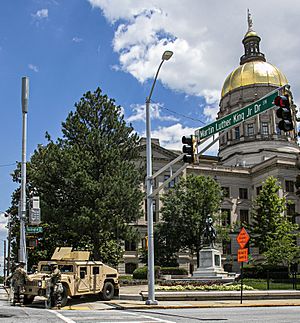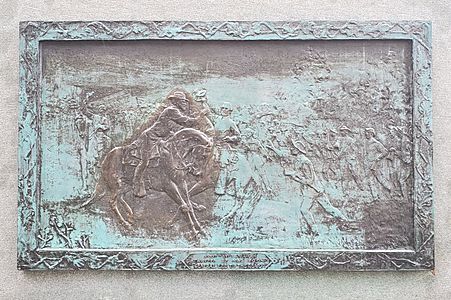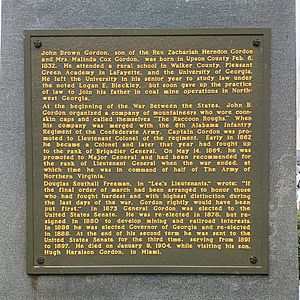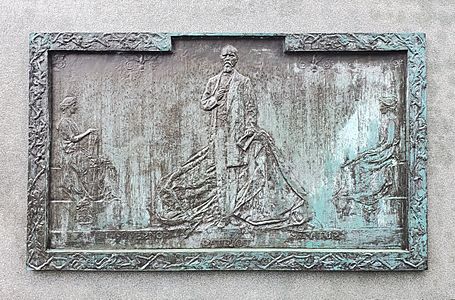Equestrian statue of John Brown Gordon facts for kids
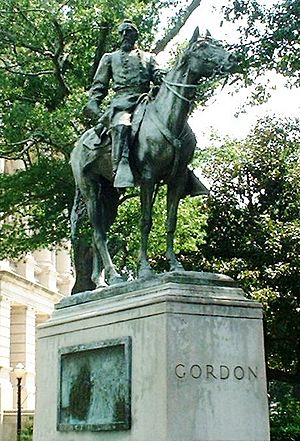
The statue in 2005
|
|
| Coordinates | 33°44′59″N 84°23′18″W / 33.74972°N 84.38833°W |
|---|---|
| Location | Georgia State Capitol, Atlanta, Georgia |
| Designer | Solon Borglum Alexander Campbell Bruce (pedestal) |
| Builder | McNeel Marble Works (pedestal) |
| Type | Equestrian statue |
| Material | Bronze Granite (pedestal) |
| Length | 10 feet (3.0 m) |
| Width | 4 feet (1.2 m) |
| Height | 23 feet (7.0 m) |
| Dedicated to | John Brown Gordon |
The equestrian statue of John Brown Gordon is a large monument found at the Georgia State Capitol in Atlanta, Georgia, United States. An equestrian statue shows a person riding a horse. This statue honors John Brown Gordon, who was a general in the Confederate States Army during the American Civil War. After the war, he became an important politician in Georgia.
The statue was designed by Solon Borglum and was officially revealed in 1907. Recently, the statue has become a topic of debate. This is because of Gordon's past views and his connections to the Confederacy. Some people believe the statue should be removed.
Contents
History of the Gordon Statue
How the Statue Was Created
John Brown Gordon was a well-known general for the Confederate States of America during the American Civil War. After the war, he served as a Senator for Georgia and also as Governor of Georgia. Gordon was also seen as a leader of the Ku Klux Klan in Georgia, a group that promoted white supremacy. He supported the practice of slavery and the idea of the Lost Cause of the Confederacy. This idea suggested that the Confederacy's cause was noble, often ignoring the role of slavery.
After Gordon passed away on January 9, 1904, leaders in Atlanta started planning a monument to honor him. On January 19, 1904, a meeting was held at the Georgia State Capitol. Groups like the United Daughters of the Confederacy and the United Confederate Veterans were there. At this meeting, Clement A. Evans suggested building a statue for Gordon.
A group called the John B. Gordon Monument Association was formed to raise money for the statue. William Lowndes Calhoun was its president. The group raised a lot of money, but they still needed $25,000 from the state government to finish the project. Solon Borglum was chosen to design the equestrian statue of Gordon. The statue would stand on a pedestal designed by Alexander Campbell Bruce and built by the McNeel Marble Works.
The statue was officially revealed on May 25, 1907, at the Georgia State Capitol. It is the only equestrian statue in Atlanta. Clement Evans gave the main speech at the event. Two of Gordon's daughters helped to unveil the statue. Many people came to watch the ceremony. Reports from that time say a choir sang "Dixie" and the crowd cheered loudly. The event happened less than a year after the Atlanta Massacre of 1906. In April 1908, a model of the statue made of plaster was shown at an art exhibition in Baltimore.
Calls for the Statue's Removal
Recently, the statue has faced criticism because of Gordon's views on race. After a tragic shooting in Charleston in 2015, a state senator suggested a law. This law would prevent official recognition of Confederate symbols, including statues like Gordon's. Around the same time, historian Kenneth W. Noe spoke to The Atlanta Journal-Constitution. He said that the Gordon statue and others at the Capitol represented the "Lost Cause" idea. In 2019, the Georgia government passed a law. This law made it illegal to remove Confederate monuments and memorials.
In 2020, during the George Floyd protests in Atlanta, many people called for the statue to be removed. The hashtag #TEARDOWNGORDON became popular on Twitter. On June 8, Bob Trammell, a leader in the Georgia House of Representatives, wrote a letter to Georgia Governor Brian Kemp. He asked the governor to remove the statue. Trammell stated that the statue's connection to hate in Georgia was "overwhelming" and that its presence was "divisive and offensive." Protests about the statue led to barriers being put up around the Capitol grounds. On June 11, a protester was arrested for writing "tear down" on the monument with chalk.
After these events, 44 of Gordon's family members sent an open letter to Governor Kemp. They also asked for the statue to be removed from the Capitol grounds. They wrote that the main reason for the statue was to celebrate and create a myth around the white supremacists of the Confederacy.
Statue Design
The monument has a bronze statue of Gordon riding a horse. It sits on a granite pedestal. Gordon's last name is carved on the front of the pedestal. The horse in the statue is based on Marye, Gordon's own warhorse from the Civil War. Gordon is shown wearing his Confederate uniform, but he looks like an older man.
On both sides of the pedestal, there are plaques that show Gordon. One plaque shows Gordon on horseback during the Battle of Spotsylvania Court House. The other plaque is a standing picture of Gordon. Below his portrait, it says "GOVERNOR PATRIOT SENATOR." A plaque on the back of the pedestal tells the story of Gordon's life. It covers his birth, his military and political career, and his death in 1904.
-
A carving showing the Battle of Spotsylvania Court House
The base of the monument is about 8 feet (2.4 m) long, 4 feet (1.2 m) wide, and 12 feet (3.7 m) tall. The statue itself is about 10 feet (3.0 m) long, 3 feet (0.91 m) wide, and 11 feet (3.4 m) tall.
See also
 In Spanish: Estatua ecuestre de John Brown Gordon para niños
In Spanish: Estatua ecuestre de John Brown Gordon para niños
- 1907 in art
- List of Confederate monuments and memorials in Georgia
- List of equestrian statues in the United States


